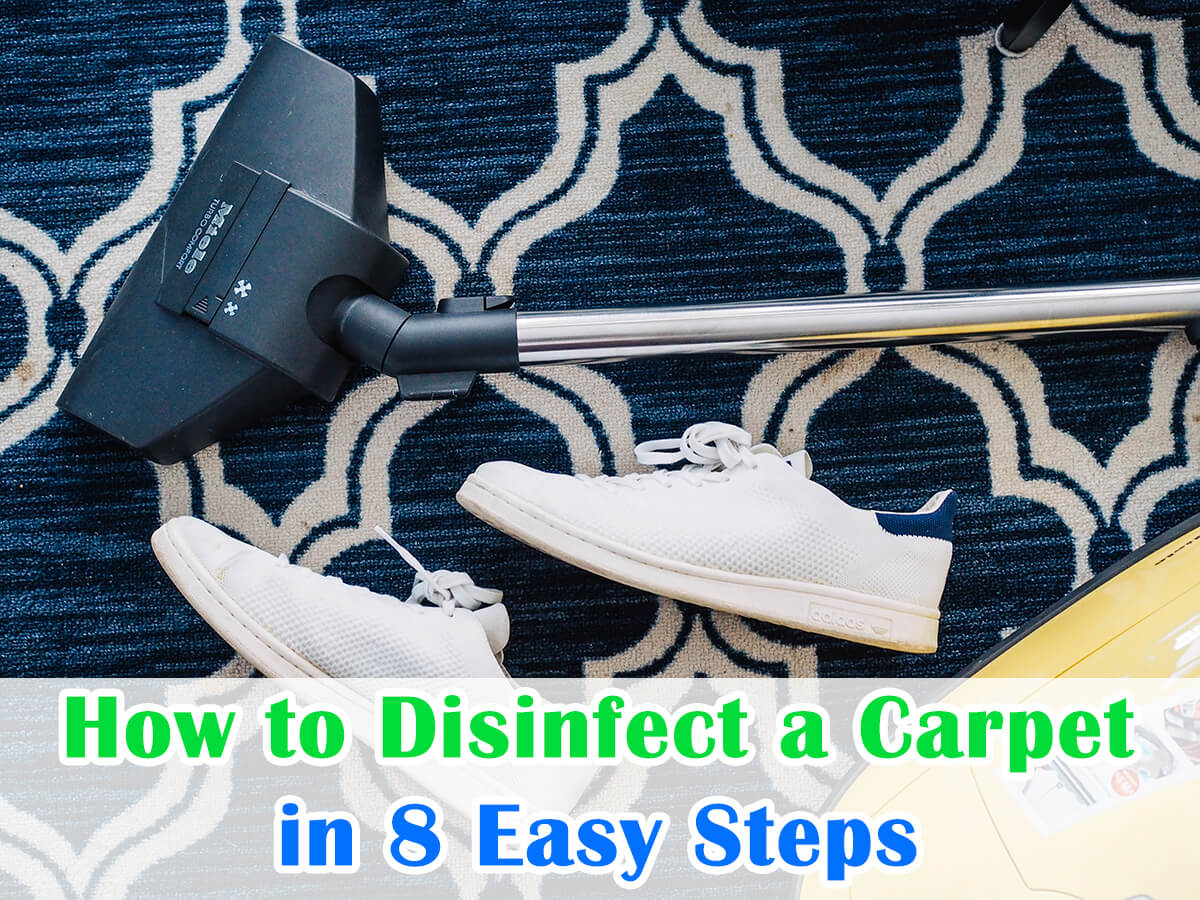Your carpet can be a breeding ground for germs, bacteria, and other contaminants. To maintain a healthy living or working environment, it is crucial to regularly clean and disinfect the carpets. While routine vacuuming is necessary to get rid of surface dirt and debris, it is not enough to get rid of germs and bacteria that can get lodged in carpet fibers. In this article, I will give you detailed guidelines on how to disinfect a carpet in just 8 easy steps.
How To Disinfect a Carpet
1. Remove Dirt and Debris
Removing dirt and debris from your carpet is an essential first step in the disinfection process. Not only does this help to prevent the spread of contaminants, but it also makes the process more effective by allowing the disinfectant to reach deeper into the carpet fibers.
To remove dirt and debris from your carpet, start by thoroughly vacuuming the carpet. Pay particular attention to high-traffic areas where dirt and debris are more likely to accumulate. A HEPA-filtered vacuum cleaner is recommended for effectively removing fine particles and allergens. The Shark N360 Navigator is the most recommended vacuum cleaner on the market because it can thoroughly clean any carpet. It includes a HEPA filter, swivel steering, a large dust cup, and other features. It also has over 30,000 positive reviews on Amazon, so you should definitely look into it.
I typically complete this step outside to stop the spread of any potentially dangerous particles that might be released during the vacuuming procedure. This is especially important if you are vacuuming in a spot that has recently received chemical treatment or if you are working with a carpet that is very dirty or contaminated.
Once you’ve finished vacuuming, go over the carpet with a lint roller or a fine-bristle brush to remove any remaining dirt or debris that may have been missed by the vacuum. This will warrant that the carpet is as clean as possible before proceeding with the disinfection.
The following video from Clean That Up channel shares a few more carpet cleaning tips:
2. Pre-Treat Stains
If your carpet has any stains or heavily soiled areas, it is a good idea to pre-treat them with a carpet stain remover before proceeding to the next step. While it is not always possible to completely remove all stains, pre-treating them can help to significantly reduce their visibility and minimize their impact on the overall appearance and cleanliness of your carpet.
A few essential tips on stain removal:
- Act quickly: The sooner you address a stain, the easier it will be to remove. I prefer tackling the stain as soon as it occurs to minimize the risk of it becoming embedded in the carpet fibers.
- Choose the right stain remover: Not all stain removers are created equal, and it is important to choose a product that is suitable for the type of stain you are dealing with. For example, protein stains (such as blood or vomit) may require a different type of stain remover than tannin stains (such as coffee or red wine). Read the label carefully and choose a product that is specifically designed to tackle the type of stain you are dealing with.
- Use a white cloth or paper towel: When blotting the stain, use a white cloth or paper towel. Colored cloths or towels can transfer dye to the carpet, potentially making the stain worse. White cloths or towels are less likely to transfer dye and will allow you to see the progress you are making in removing the stain.
After pre-treating the stain, rinse the area with water to remove any remaining stain remover and the stain. Use a damp cloth or a carpet cleaning machine to rinse the area and blot the carpet dry to remove any excess moisture. Allowing the carpet to remain damp can lead to the growth of mold or mildew, which can cause further damage to the carpet and create an unhealthy environment.
3. Choose a Disinfectant
When disinfecting a carpet, choose a disinfectant that is safe for use on carpets and will effectively kill any germs, bacteria, or fleas present. According to American Lung Association, carpets can be a real health hazard, trapping allergens, pollutants, mold spores, lead, and more. Which is why selecting the best possible disintfectant is crucial for the task ahead.
Some common disinfectant types I’ve tried include:
- Hydrogen peroxide: This is a natural disinfectant that is safe for use on carpets and can be effective against a wide range of germs and bacteria.
- White vinegar: This is another natural disinfectant that is safe for use on carpets. Mix equal parts white vinegar and water to create a solution that can be used to disinfect the carpet.
- Diluted bleach solution: A solution of 1/4 cup of bleach to one gallon of water can be used to disinfect carpets, but it should be tested on an inconspicuous area first to guarantee it does not discolor the carpet.
- Carpet disinfectant sprays: These are specially formulated sprays that are designed for use on carpets and can be effective against a wide range of germs and bacteria.
From my personal experience, the best disinfectant for the job is Bissell Antibacterial 2-in-1 Carpet Cleaner. This powerful cleaner packs a big punch when it comes to cleaning carpets and upholstery. The deep-cleaning antibacterial formula works wonders on tough stains and odors, leaving your carpets fresh and clean. I’ve been using it for a long time and it never failed to impress me. It’s definitely a must-have for anyone looking to keep their carpets looking their best. It’s also an Amazon’s Choice product with over 3,000 positive reviews! Click here to read more reviews and compare prices.
4. Test the Disinfectant
Testing the disinfectant before treating the whole carpet ensures that the disinfectant is safe for use and will not cause any damage or discoloration. Here’s what I normally do to test the disinfectant:
- Choose an inconspicuous area of the carpet to test. This could be a small corner or a hidden area under a piece of furniture.
- Mix the disinfectant according to the manufacturer’s instructions and dilution ratios.
- Apply a small amount of the disinfectant to the test area of the carpet, using a clean cloth or sponge.
- Allow the disinfectant to sit on the carpet for the recommended time period, as stated by the manufacturer.
- Carefully examine the test area of the carpet for any signs of discoloration or damage. The disinfectant is safe to use on carpet if it doesn’t appear to have any impact on it. A different disinfectant or technique should be used if there is damage or discoloration.
- If the disinfectant is safe to use, you can treat the entire carpet.
5. Apply the Disinfectant
Once you have chosen and tested a disinfectant that is safe for use on the carpet, it’s time to apply it to the entire carpet.
Follow the manufacturer’s instructions and dilution ratios when mixing the disinfectant. Then, use a clean cloth or sponge to apply the disinfectant to the carpet. Start at one end of the room and work your way towards the other end, as you cover the entire carpet.
Pro tip: Put on gloves, a mask, and safety goggles before applying the disinfectant. Additionally, keep children and pets away from the treated area until the carpet is completely dry and safe to be walked on.
6. Let the Disinfectant Sit
Letting the disinfectant sit on the carpet for the recommended time period is an unskippable step in the carpet disinfection process, as it allows the disinfectant to fully penetrate and eliminate any germs or bacteria present in the carpet. Here are some relevant tips:
- Make sure that the room is well ventilated. Open windows and doors to allow fresh air to circulate and help the disinfectant to dry more quickly.
- Avoid walking on the carpet while the disinfectant is sitting. This can redistribute the germs or bacteria and decrease the effectiveness of the disinfectant.
- Cover the carpet with plastic sheeting or paper if necessary to prevent people from walking on the carpet.
- If possible, avoid using the room while the disinfectant is sitting. This will allow the disinfectant to work more effectively and ensure that the carpet is safe to use once it is dry.
Note: Some disinfectants may require a longer dwell time, so follow the manufacturer’s instructions carefully and let the disinfectant sit for the recommended time period. Additionally, certain types of disinfectants may require agitation to work, read the instructions carefully and agitate the disinfectant if required.
7. Rinse the Carpet
Rinsing the carpet removes any remaining disinfectant and germs or bacteria from the carpet. I recommend mixing a solution of clean water and a mild detergent (if necessary). Using a clean cloth or sponge, apply the solution to the carpet and work it in gently, going over the entire carpet. This method applies to every size and type of carpet, even if you are cleaning carpet stairs.
Don’t overwet the carpet, since excessive water can cause the carpet padding to become waterlogged and lead to mold growth.
Afterwards, use a carpet cleaner machine or a different clean cloth to remove the solution and any remaining debris from the carpet. Remember to rinse the carpet thoroughly to remove all traces of disinfectant and detergent.
8. Dry the Carpet
Drying the carpet properly helps to remove any remaining germs or bacteria and makes the carpet safe to use. Depending on the type of carpet and the humidity level, it may take several hours to a day for the carpet to dry completely.
If possible, use a fan or open windows and doors to increase air circulation and speed up the drying process. Avoid walking on the carpet while it is still wet, as this can redistribute the germs or bacteria and decrease the effectiveness of the disinfectant.
At this point, if I see that the carpet is taking a long time to dry, or if there is a lot of moisture present, I would use a dehumidifier to help remove excess moisture from the air.
Once the carpet is completely dry, it is safe to use and replace any furniture that was removed earlier. Regularly vacuum the carpet, to remove any dust and dirt that may have accumulated during the drying process.
It is best to get in touch with a professional cleaner to assess the damage and suggest a course of action if you notice any discoloration, shrinkage, or other damage after the carpet has dried.
In Conclusion
I hope that by sharing my experience, you are now better prepared to tackle the carpet disinfecting task. By following these steps, you can effectively disinfect your carpet and maintain a clean and healthy environment. Cleaning and disinfection are especially important in homes with children or pets, as well as in places like schools, offices, and healthcare facilities.
I have also posted an article that tackles a more general cleaning task – how to clean your carpet in 10 easy steps. Be sure to give it a look, there might be carpet-cleaning steps that you’ve been skipping!
Happy cleaning!


